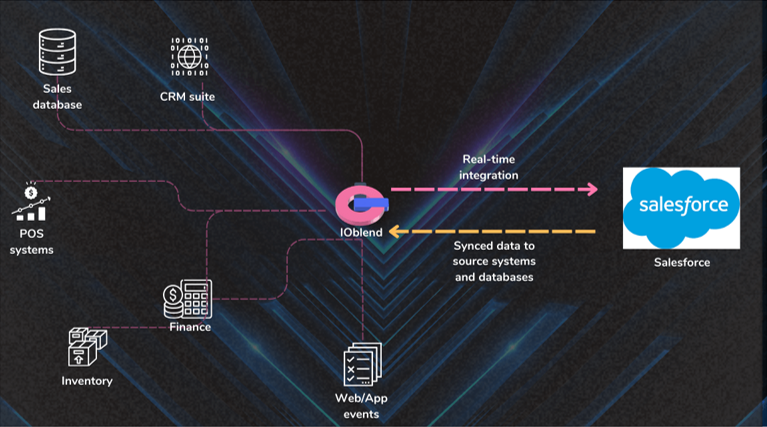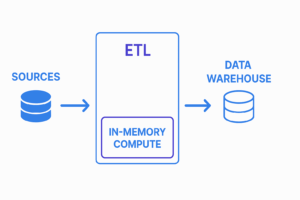Golden Record: Finding the Single Truth Source
How often do you sift through multiple details of the same customer to find the up-to-date ones? Come on, be honest. That’s what I thought: quite often, even in the largest CRM systems like Salesforce. Our latest use case we dealt with had six entries for each customer across the organisation. All were correct at a given point of time, but none were collated into a single golden record.
So, which one should I use? A 64K dollar question in many businesses.
Creating a golden data record in CRM systems is a crucial aspect of maintaining data integrity. Poor data integrity means reduced competitiveness, reputational damage, failure to meet regulatory standards, difficulty in making evidence-based decisions, etc. Which John Smith is this? Or is it even a John Smith at all and not Jon Smith or John Smyth? We got all three with the same residential address…
A golden record of data refers to a consolidated dataset that serves as a single source of truth for all the data a business holds about a customer, employee, or product.
Why we need a golden data record
As the amount of data stored across multiple systems increases, the probability of errors and mismatches among those data records also rises. This can make data difficult and time-consuming to use. Without a golden record, data is often duplicated and incomplete across various databases. Issues like multiple versions of someone’s name or addresses for the same individual proliferate.
Which data record is correct? The address in the utilities bill or the bank? Should we take the latest one? But it doesn’t seem to have a post code. But hey, the utilities address does, although it is not the freshest record.
Slowly changing dimensions (SCD) are another layer of complexity. People move homes, change jobs, replace phone numbers, etc, so the customer data is rarely static. And it changes at random intervals, often with many years between the changes.
Primary uses of a golden data record
Ok, it’s a pain to have multiple data records in different systems. But why do I care? We managed so far.
Compliance and regulation: Having a golden record greatly simplifies compliance-related requests, such as a Subject Access Request (SAR) under GDPR and DPA legislation. Businesses can easily provide all the necessary data, including details on where and how it’s stored.
Business decision-making: It enables more incisive decision-making by providing greater insights into a dataset, like noticing consumer behaviour trends to develop new products or marketing strategies.
Enhanced marketing activity: Marketers get a more holistic and meaningful picture of their customers, allowing for highly targeted campaigns and better personalisation.
Improved revenue collection: If your business issues recurring bills, you need to make sure you send them to the right customer, at the right address and for the right amounts. This is a big issue with utilities providers, often delaying (and losing) millions in revenue inflows.
Reduction in operational complexity: Operational costs, such as data storage and manual data wrangling, are reduced. Data can be more quickly and easily searched and analysed due to its availability in high quality and in a centralised form.
Challenges with golden data records
So golden records are a force for good. How do we go about creating and managing a golden record then? Well, it’s not quite as straightforward as a lot of marketing pitches may get you to think. There are a number of challenges you must consider.
Data quality: Ensuring the accuracy, completeness, and reliability of data from diverse sources.
Data integration: Harmonising data from different systems, which may have varying formats and standards.
Duplicate data: Identifying and resolving duplicate records across systems to create a singular, accurate record.
Data updating: Keeping the golden record updated with the latest, correct information while synchronising changes across all systems.
Compliance and security: Adhering to data protection regulations and ensuring the security of sensitive data during integration and storage is crucial.
Scalability: As organizations grow, the systems and data volumes expand, making it harder to maintain the integrity and consistency of the golden record.
User adoption and training: Ensuring that all stakeholders understand and adhere to processes for maintaining the golden record requires effective change management.
These challenges demand a combination of robust data management strategies, effective use of technology, and ongoing governance to maintain the integrity and value of the golden data record.
Maintaining a golden record across multiple systems
To establish a golden record, organisations need to undertake a series of steps. Most need to be technical and automated, especially if the scale of the data is large. Manually reconciling 100K changes per week is a fruitless task. The AI can help, but it’s sticking a plaster if you just replace human intervention with AI. You need to address the vast majority of the data at the source, before it ever gets into the “unmatched” bucket.
Identifying and standardising data: Identify all sources of data and ensure they are complete and accurate. Standardise the format of the fields to match the requirements of the golden record. You can’t always rely on the source data primary keys to do that either.
Matching and merging data: Identify matches in the data to remove duplicates and decide which field from which data source should be the authoritative version.
Data source selection and cleansing: Establish well-designed data source selection and cleansing criteria, including manual data cleansing where needed.

How IOblend creates and manages golden records
IOblend is a highly flexible data integration solution with built-in DataOps capabilities, which is especially powerful for creating and maintaining golden records across multiple systems.
Data integration and transformation: IOblend’s Apache Spark™ data pipelines enable the integration and transformation of real-time and batch data, facilitating the creation of golden records. We ingest the data into in-memory data frames, generate and maintain our own primary keys, created and modified timestamps, among other fields that standardise the records without being dependent on any source system.
Versatility and efficiency: It offers low code/no code development, which reduces the cost and effort of data pipeline development. We deployed into prod an automated Salesforce CRM data pipeline (shown) to manage the golden record in just three days. In this use case, the company setup Salesforce as the single source of the truth.
Support for diverse data architectures: we support both centralised and federated data architectures, cloud, on-prem or hybrid, ensuring compatibility with a wide range of systems and data formats. IOblend is completely system-agnostic and enables a modular architecture (i.e. easily swap upstream and downstream systems).
Automated DataOps: Features like record-level lineage, change data capture (CDC), metadata management, SCD management and de-duping are integral parts of IOblend’s automated DataOps, crucial for maintaining the integrity of a golden record and syncing changes across all systems.
Endless scalability: IOblend is built with big data principles in mind, so it processes as much data as you throw at it seamlessly. There is no need to rebuild your data pipelines as the data volumes grow.
The quest for a golden record
The quest for the golden record is not just a technical challenge but a strategic imperative for businesses. It involves creating a single, accurate, and comprehensive record of customer data by overcoming various hurdles such as data quality, integration, duplication, and updating. The benefits of a golden record are immense, ranging from enhanced compliance and decision-making to streamlined operations and targeted marketing.
However, achieving this requires a careful blend of technology, governance, and change management. As data continues to grow and evolve, the importance of maintaining a golden record becomes ever more vital for businesses seeking to harness the full potential of their data assets and reduce data wrangling cost.
Drop us a note to learn how we can enable golden record creation and management in your organisation.
IOblend presents a ground-breaking approach to IoT and data integration, revolutionizing the way businesses handle their data. It’s an all-in-one data integration accelerator, boasting real-time, production-grade, managed Apache Spark™ data pipelines that can be set up in mere minutes. This facilitates a massive acceleration in data migration projects, whether from on-prem to cloud or between clouds, thanks to its low code/no code development and automated data management and governance.
IOblend also simplifies the integration of streaming and batch data through Kappa architecture, significantly boosting the efficiency of operational analytics and MLOps. Its system enables the robust and cost-effective delivery of both centralized and federated data architectures, with low latency and massively parallelized data processing, capable of handling over 10 million transactions per second. Additionally, IOblend integrates seamlessly with leading cloud services like Snowflake and Microsoft Azure, underscoring its versatility and broad applicability in various data environments.
At its core, IOblend is an end-to-end enterprise data integration solution built with DataOps capability. It stands out as a versatile ETL product for building and managing data estates with high-grade data flows. The platform powers operational analytics and AI initiatives, drastically reducing the costs and development efforts associated with data projects and data science ventures. It’s engineered to connect to any source, perform in-memory transformations of streaming and batch data, and direct the results to any destination with minimal effort.
IOblend’s use cases are diverse and impactful. It streams live data from factories to automated forecasting models and channels data from IoT sensors to real-time monitoring applications, enabling automated decision-making based on live inputs and historical statistics. Additionally, it handles the movement of production-grade streaming and batch data to and from cloud data warehouses and lakes, powers data exchanges, and feeds applications with data that adheres to complex business rules and governance policies.
The platform comprises two core components: the IOblend Designer and the IOblend Engine. The IOblend Designer is a desktop GUI used for designing, building, and testing data pipeline DAGs, producing metadata that describes the data pipelines. The IOblend Engine, the heart of the system, converts this metadata into Spark streaming jobs executed on any Spark cluster. Available in Developer and Enterprise suites, IOblend supports both local and remote engine operations, catering to a wide range of development and operational needs. It also facilitates collaborative development and pipeline versioning, making it a robust tool for modern data management and analytics

PoC to Production: Accelerating AI Deployment with IOblend
PoC to Production: Accelerating AI Deployment with IOblend💭 Did You Know? While a staggering 92% of companies are actively experimenting with Artificial Intelligence, a mere 1% ever achieve full maturity in deploying AI solutions at scale. The AI Production JourneyA Proof of Concept (PoC) in AI serves as a small-scale, experimental project designed to validate

AI in Healthcare with Smart Data Pipelines
AI in Healthcare: Powering Progress with Smart Data Pipelines 💉 Did you know? Hospitals in the UK alone produce an astonishing 50 petabytes of data per year, more than double the data managed by the US Library of Congress in 2022! What are Data Pipelines for AI Model Training? In the context of healthcare, this means

The Urgency of Now: Real-Time Data in Analytics
The Urgency of Now: Real-Time Data in Analytics ✈️ Did you know? Every minute of delay in airline operations can cost as much as £100 per minute for a single aircraft. With thousands of flights daily, those minutes add up fast. Just like in aviation, in data analytics, even small delays can lead to big

Still Confused in 2025? AI, ML & Data Science Explained
Still Confused in 2025? AI, ML & Data Science Explained…finally It seems everyone in business circles talks about these days. AI will solve all our business challenges and make/save us a ton of money. AI will replace manual labour with clever agents. It will change the world and our business will be at the forefront

Beyond Spreadsheets: The CFO’s Path to Data-Driven Decisions
Beyond Spreadsheets: The CFO’s Path to Data-Driven Decisions 📊 Did you know? Companies leveraging data-driven insights consistently report a significant uplift in profitability – often exceeding 20%. That’s not just a marginal gain; it’s a game-changer. The Data-Driven CFO The modern Chief Financial Officer operates in a world awash with data. No longer solely focused

Shift Left: Unleashing Data Power with In-Memory Processing
Mind the Gap: Bridging Data Shift Left: Unleashing Data Power with In-Memory Processing 💻 Did you know? Organisations that implement shift-left strategies can experience up to a 30% reduction in compute costs by cleaning data at the source. The Essence of Shifting Left Shifting data compute and governance “left” essentially means moving these processes closer

